The Tyan S8236WGM3NR packs two socket G34 CPUs and up to 24 Magny-Cours cores and sixteen DDR3 DIMM slots in a 1U/ 2U friendly form factor. One area admittedly ServeTheHome has been lacking in is covering the AMD G34 and C32 platforms. I plan to do a much larger piece on some CPUs in the near future, but I thought I would start by showing off one of the new platforms. With AMD’s Magny-Cours architecture, AMD is giving the user more physical cores than Intel, per package, versus the Xeon E, L and X series CPUs. One of the most exciting things about the G34 platform is that many of today’s boards will be compatible with the new Interlagos CPUs (server version of AMD’s upcoming Bulldozer architecture). The Tyan S8236WGM3NR is an unconventional layout, but a feature-packed low profile board.
Test Configuration
Recently I acquired two AMD Opteron 6164 HE’s and eight Opteron 6166 HE’s and the 6164 HE chips were used for this review.
- CPUs: 2x AMD Opteron 6164 HE’s
- Motherboard: Tyan S8236WGM3NR
- Memory 8x 2GB ECC DDR3 UDIMMs
- OS Drive: OCZ Agility 2 120GB
- Enclosure: Norco RPC-4224
- Power Supply: Seasonic X650 (650w Gold level power supply)

Probably the biggest reason to look at the HE parts is their relatively low power consumption which is a desirable trait in 1U and 2U environments.
Board Layout
One of the most striking things about the board is the overall layout. The CPUs align on the right side of the board with DIMMs flanking the outer sides of the CPUs.
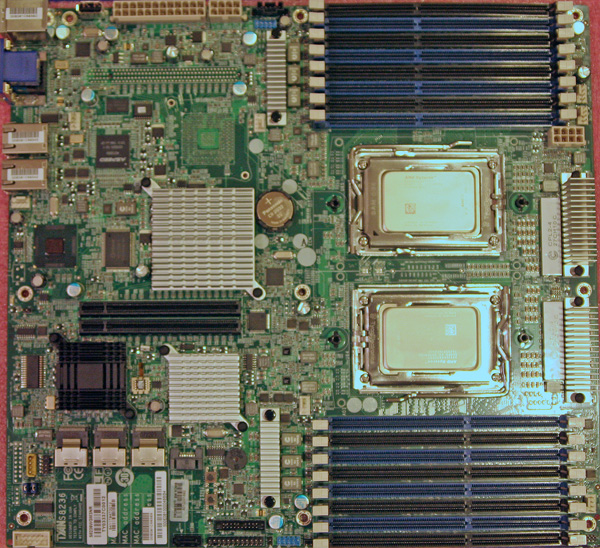
The entire board is aligned to allow smooth airflow from the right side of the board to the left side of the board and outside of the chassis. Combined with the relatively low power consumption of the Opteron HE parts, optimized airflow allows for fans to spin at an even slower rate, thereby saving even more power. In a 3U or 4U chassis components are less densely packed so this layout can give way to a more standard staggered CPU and memory layout. Even the internal USB header is located along the top edge of the board near the rear I/O ports.
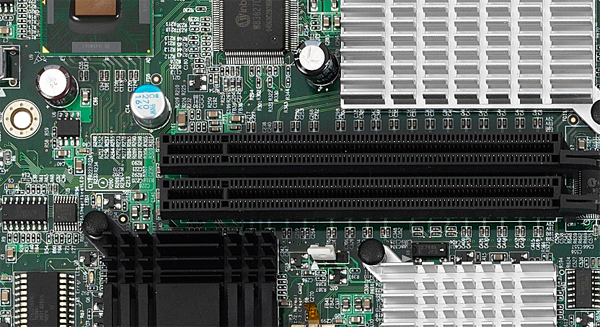
One will probably note two very closely packed expansion slots in the very middle of the board. These slots are situated as such to provide appropriate attach points for 1U and 2U PCIe riser cards.
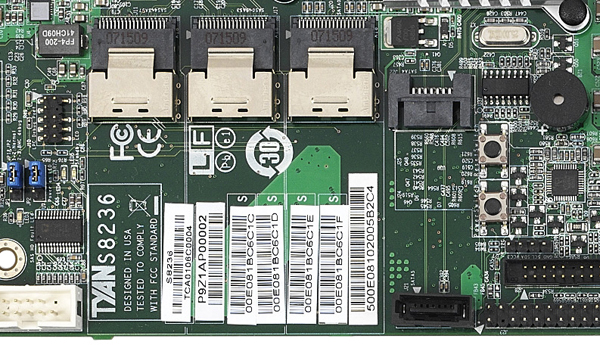
The other main note is the SAS and SATA connectors. From left to right, top to bottom there are two SFF-8087 connectors for the onboard LSI SAS2008 controller, a four port SATA SFF-8087 connector, a SATA connector parallel to the motherboard plane and a SATA connector perpendicular to the motherboard plane. These six SATA II 3.0gbps ports all are connected through the AMD SP5100 that includes Promise RAID 0/1/10/5 under Linux. Overall one can connect up to 14 drives using onboard controllers. As an aside, one can see the ever-present power and reset switches that come in handy during diagnostic sessions.
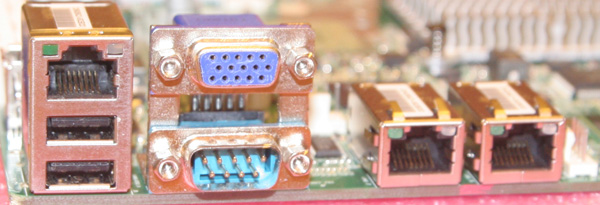
Rear I/O panel connectors are fairly simplistic with the Intel 82574L management NIC, two USB ports, a VGA port, serial port and two RJ45 connectors linked to an Intel 82576EB. It is interesting that Tyan uses an Intel controller for the management NIC because vendors like Supermicro use a less expensive Realtek 10/100 NIC for management features. Furthermore, it should be noted that Tyan allows a user the flexibility of using the management NIC as a data NIC.
Features
Tyan’s IPMI 2.0 interface will be fairly intuitive if one is accustomed to other modern KVM-over-IP implementations. One can either use external IPMI tools or navigate to a web based interface. I will note that I initially had a few problems with the IPMI 2.0 management NIC not showing up on my network but this was resolved by flashing the BMC BIOS to the newest version.
Being able to remotely manage servers through the IPMI interface is a major time saver. One can troubleshoot common issues, including kernel panics that leave one without access to the machine otherwise, remotely. Even things such as BIOS changes can be accomplished through the web GUI.
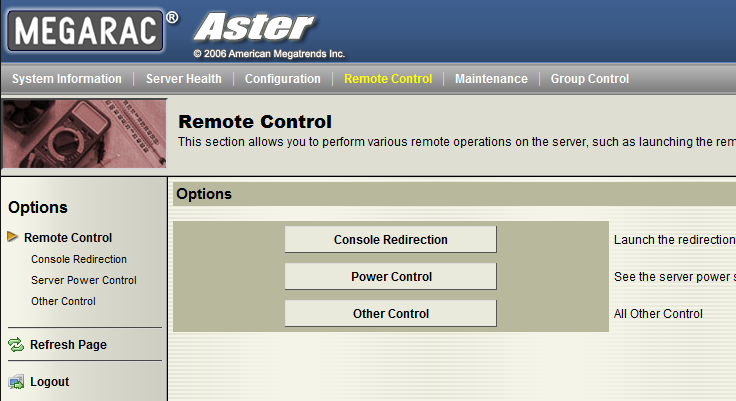
Users will find standard features such as the ability to control power functions of the server through the baseboard management controller and web interface along with standard features like remote monitoring of fans, temperatures and other sensors.
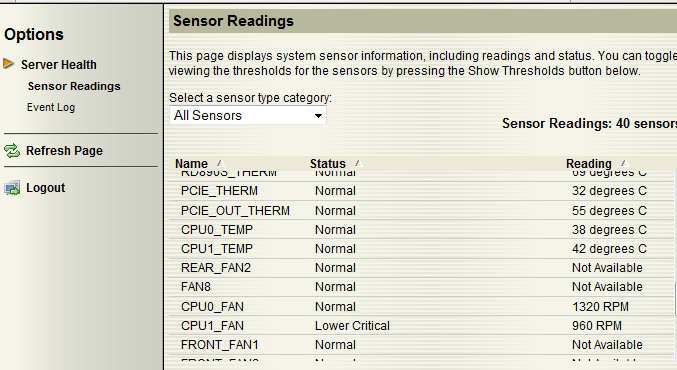
One of the most important features is the JAVA based KVM-over-IP functionality that allows a user to do several things. First, one can use a keyboard and mouse on a local machine to control the host. Second, one can remotely mount ISOs, local optical drives and etc. onto the server. These features are important to most users unless an external KVM-over-IP solution is used and one has a network switched power distribution unit (or multiple if a redundant PSU is used) that can power cycle a server.
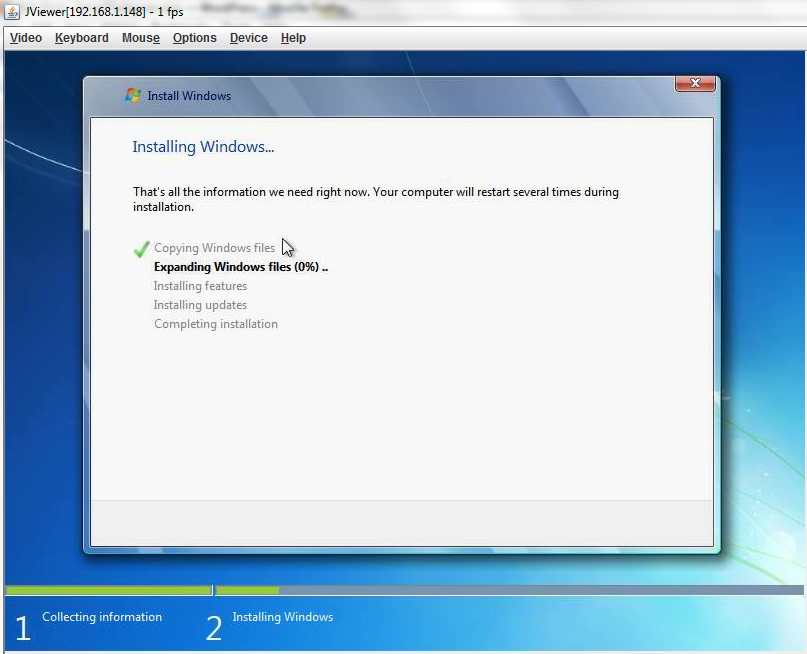
Overall, Tyan provides the requisite remote management functionality to compete in the UP server market. To any potential buyer, I would strongly suggest getting a board with these features as they have become necessary management tools for machines not acting as primary workstations. In the near future Tyan’s remote management capabilities will be the subject of an in-depth piece on this site in the near future.
One preview note, running 100% CPU utilization on the Tyan S8236WGM3NR with two 6164 HE’s and the LSI SAS2008 controller active yielded an impressive 226w of power draw from the twenty four core monster. This was a surprisingly excellent result, but does show that adding 1U chassis fans over that figure can easily add 10-20% more power consumption. That is one prime reason why the board’s layout is uniquely suited to lower power consumption in those situations.
Conclusion
Overall the Tyan S8236WGM3NR is a solid dual socket platform for the AMD G34 CPUs. In both layout and expansion capabilities it is tailored for the 1U and 2U markets which is very important for a business trying to achieve a higher core per 1U count in their datacenter. The addition of the LSI SAS2008 controller on a board like this allows one to utilize eight new SATA 3.0gbps drives, a fairly common 1U setup. Triple Intel LAN ports supported under ESXi make life easier if one does not utilize the management solely for IPMI 2.0 management. As will be seen in future articles, this is a fast platform.
Feel free to discuss this article on the ServeTheHome.com Forums!




You are doing AMD Optys now? A welcome development. Keep up the great work. Nobody else covers this stuff well.
nice. do quads soon too,